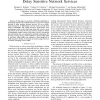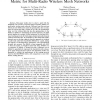81
Voted
DATE
2006
IEEE
15 years 6 months ago
2006
IEEE
— Traffic shaping is a well-known technique in the area of networking and is proven to reduce global buffer requirements and end-to-end delays in networked systems. Due to these...
111
Voted
MSN
2007
Springer
15 years 6 months ago
2007
Springer
Some of the routing algorithms in mobile ad hoc networks use multiple paths simultaneously. These algorithms can attempt to find nodedisjoint paths to achieve higher fault toleranc...
88
Voted
INFOCOM
2007
IEEE
15 years 6 months ago
2007
IEEE
— This paper presents an algorithm for maximizing the lifetime of a sensor network while guaranteeing an upper bound on the end-to-end delay. We prove that the proposed algorithm...
124
click to vote
ICC
2007
IEEE
15 years 6 months ago
2007
IEEE
—We present a multi-constrained routing algorithm, called Delay-constrained Pool Sharing (DPS), in a survivable mesh network. The goal of this algorithm is to find a pair of link...
126
click to vote
WCNC
2008
IEEE
15 years 6 months ago
2008
IEEE
Abstract— In wireless sensor networks, one of the big challenges is to achieve a satisfactory network lifetime while meeting quality of service (QoS) requirements. In this paper,...
ICC
2008
IEEE
15 years 6 months ago
2008
IEEE
Abstract ⎯ Currently, the most advanced framework for stochastic network calculus is the min-plus algebra, providing bounds for the end-to-end delay in networks. The bounds calcu...
110
Voted
GLOBECOM
2008
IEEE
15 years 7 months ago
2008
IEEE
—In this paper, we present a distributed algorithm to dynamically allocate the available resources of a service-oriented network to delay sensitive network services. We use a uti...
110
click to vote
GLOBECOM
2008
IEEE
15 years 7 months ago
2008
IEEE
—The routing problem in Wireless Mesh Networks is concerned with finding “good” source-destination paths. It generally faces multiple objectives to be optimized, such as i) ...
114
Voted
FGCN
2008
IEEE
15 years 7 months ago
2008
IEEE
This paper addresses the routing problem in packet switching free-space optical (FSO) mesh networks. FSO mesh networks are emerging as broadband communication networks because of ...
120
Voted
INFOCOM
2009
IEEE
15 years 7 months ago
2009
IEEE
—This paper studies how to select a path with the minimum cost in terms of expected end-to-end delay (EED) in a multi-radio wireless mesh network. Different from the previous eff...





